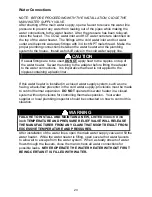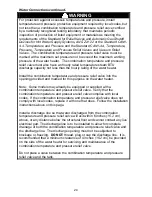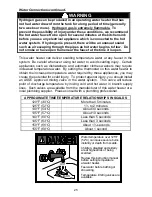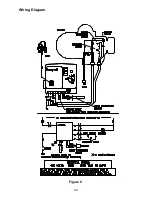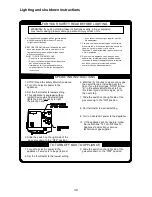
37
Troubleshooting continued-
Six flashes-four
flashes, three second
pause
Undesired-false pilot
flame sensed.
System auto resets.
Seven flashes, three
second pause
Simulated Resistive
Device Harness out of
specification or
disconnected, or
Flammable vapor sensor
fault detected.
Eight flashes-one
flash, three second
pause
Simulated Resistive
Device Harness, or
Flammable vapor sensor
out of specification
possible short.
T'stat well & sensor
damaged or unplugged
or
Gas valve electronics
fault detected
Eight flashes-three
flashes, three second
pause
LED Status
Control Status
Probable Cause
1. Pilot valve stuck in open position.
Simulated resistive load out of specification, or
Flammable vapor sensor failure.
Simulated resistive load out of specification, or
Flammable vapor sensor out of specification.
1. Damage to thermowell wire.
2. Thermowell sensor resistance out of range.
3. Replace thermowell.
4. Verify control is not wet or physically damaged
5. Reset control on/off switch.
6. Replace electronic module if 8-3 error persists
Eight flashes-four
flashes, three second
pause
Gas valve fault detected.
1. Verify control is not wet or physically damaged
2. Reset control on/off switch.
3. Replace gas control if 8-4 error persists
Six flashes-three
flashes, three second
pause (Soft lockout)
Pilot flame extinguished.
System resets after 5
minutes.
1. Unstable pilot.
2. Pilot tube blocked or restricted.
3. Oxidation build up on pilot electrode.
4. Wire damage to pilot assembly or bad
connection at gas valve.
5. Insufficient combustion air.
Control Sequence of Operation
Start up Sequence
Upon powering up, the control checks for the presence of the resistive plug, if the
resistance is in the expected range the control will begin normal operation after 5 to 8
seconds.
Normal Heating Sequence
1. The thermostat senses a need for heat.
2. The control checks the pressure switch condition.
3. If the pressure switch is open, the control sends power to the blower motor.
4. The blower starts moving combustion air through the combustion system.
5. The pressure switch closes.
6. The control senses the closed pressure switch and starts the ignition process by
providing a spark at the pilot electrode and allowing gas to flow to the pilot.
7. When the pilot is lit the gas control senses the pilot flame and opens the main gas
valve.
8. The main burner is lit.
9. The main burner and blower continue to operate until the thermostat is satisfied.
10. When the thermostat is satisfied the main and pilot gas valves close.
11. The blower operates for a short post purge period before shutting down.
12. The water heater remains in the stand-by mode until the next call for heat.
Summary of Contents for 238-45917-OON
Page 28: ...28 Wiring Diagram Figure 6 ...
Page 40: ...40 NOTES ...

